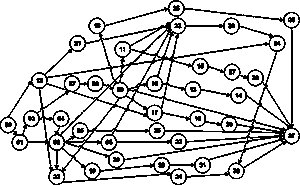
Psychologists say that most entrepreneurs have primAtive thinking (from the word “primate”, not “primitive” ).
Individuals with this type thinking make decisions based on their intuitive feelings.
Therefore, primAtive businessmen can be called “managerial beasts”.
Intuitive decisions are quite effective in simple cases.
In complex problems, especially innovative ones, intuitive decisions are often ineffective and even hurtful.
Profitable solutions to complex problems can only be made based on scientific knowledge and methods.
A necessary sign of the scientificity of knowledge and methods is their compliance with the following classical principles of epistemology:
– Represent knowledge in the form of separate descriptions of the properties of the studied and designed objects;
– Do not allow incorrect terms, logical contradictions, inconsistencies with facts;
– Evaluate projects on the materials of correct discussions between their proponents and opponents.
The natural sciences and engineering are based on these principles.
Knowledge is a set of separate descriptions of the elementary properties of objects being studied or designed.
Therefore, knowledge has a discrete structure.
The description of one property is a thought.
Each thought should be visually separated from other thoughts, for example, in a separate paragraph.
Scientific knowledge, scientific thinking, and scientific communication should be discrete and operate with separate descriptions of the object properties.
The discrete structure is a necessary property of scientific knowledge.
Knowledge devoid of discreteness and presented in a flow format should not be considered scientific.
The main function of scientific communication is to detect errors in the descriptions of separate properties of objects – incorrect terms, logical contradictions, and inconsistencies with facts.
Therefore, the subjects of scientific discussions should be surmised errors in separate descriptions of specific properties of objects.
Analyzing and discussing texts in which descriptions of object properties are separated insufficiently, are significantly difficult and ineffective, up to their factual futility or impossibility.
Contrary to the long-standing triviality of the principles of epistemology, the practice of corporate and public management shows a massive disregard for these principles in designing and making decisions.
Instead of descriptions of separate project properties in the discrete format, managers often use information in the flow format that causes and conceals errors and complicates their detection, greatly impedes logical thinking and intellectual communication.
As a result, they use incorrect terms, logical errors, and inconsistencies with facts.
Managers spend a lot of time in inefficient meetings and make decisions without proper procedures for discussing projects.
Therefore, they make erroneous decisions that worsen management and damage corporations.
The more complex the project and the object of management, the more epistemological principles are violated, and decisions are made on the basis of intuition and rhetoric, but not knowledge and logic.
Top managers often make decisions about the implementation of inventions, technologies, productions, investment, and corporate projects that change very complex economic and social systems.
These systems have technical, organizational, financial, market, competitive, legal, advertising, labor, psychological, logistical, environmental, political, and other components.
In the vast majority of cases, these systems are too complex.
Therefore, managers do not know their properties sufficiently and are unable to anticipate the results of their changes.
As a result, decision-making based on managers’ personal knowledge in most such cases causes erroneous decisions, the implementation of which reduces profits and increases losses.
Managers do not have the time, energy, wish to study the justifications for projects proposed by experts.
Therefore, they usually intuitively trust some experts and adopt their project decisions.
However, the interests and competencies of experts, even trusted ones, to some extent differ from the interests and competencies of managers and, especially, from the interests of owners (shareholders) of corporations.
Therefore, their projects often do not produce the optimal achievement of the goals of managers and owners.
In scientific methodology, the so-called “judicial” method, which minimizes the probability of errors in making complex decisions, is well known.
It does not require managers to have special knowledge of the properties of changed systems and to study projects in detail.
Its main function is to detect possible errors in projects – incorrect terms, logical contradictions, and inconsistencies with facts – in the process of textual discussions of projects between their proponents (authors) and opponents (critics).
Opponents report surmised errors in projects. Proponents report errors in opponents' arguments. Moreover, “conflicts of interest” between proponents and opponents should operate.
Managers mainly study only the disputed theses of the discussions, draw conclusions about the presence or absence of errors in projects, and reject projects containing errors.
In order for managers to remain objective when evaluating the arguments of the debaters, they themselves should not participate in the discussions.
Thus, decision-making consists of three stages – preparing projects, discussing them by experts, and evaluating the discussion materials by managers.
Project and discussion materials should be presented in the discrete format.
Each paragraph should describe one elementary property of a changed system and the process of changing it.
As is known, every project should include three mandatory parts:
Description of the current state of the system that the project will change, including a description of the problems that the project should eliminate, and the factors causing them.
Description of the target state of the system, which should be achieved as a result of the implementation of the project, including criteria for achieving the project goals.
Description of the process of changing the system from its current state to the target state, including the resources available and required for the implementation of the project.
Despite the triviality of this requirement, in practice, these parts are often combined to varying degrees. Factors causing problems are not sufficiently described. Criteria for optimal achievement of project goals are formulated inaccurately. Sometimes, descriptions of the current and target states are absent quite. This greatly complicates the detection of project errors and their adequate evaluation.
The described method is universal and can be applied in the management of factories, corporations, and ministries, for decision-making in political parties, parliaments, and governments.
To some extent, this method is similar to the well-known “Japanese” management method, in which draft decisions are discussed with all departments involved.
The more complex projects are, the more this method reduces the probability of erroneous decisions relative to traditional methods. In corporate projects, this probability decreases several times. In social projects – dozens of times.
Despite the effectiveness of this method, it is used in management very rarely. Some managers just do not know it. Others save on expensive experts. Still others are simply too lazy to strain their brains on the study of discussion materials. “Managerial alpha males” prefer to sit for thousands of hours in inefficient meetings, enjoy their power there, make important decisions in restaurants and saunas.
Due to traditional, archaic management, corporations suffer huge losses.
The probability of erroneous decisions about investing in innovative enterprises that do not have reliable statistics, is especially high. The procedures for evaluating such projects are based only on the intuitive feelings of venture investors. Therefore, investors often finance unprofitable projects and reject potentially profitable ones.
Thus, the application of epistemological principles in management includes the following practical measures:
Establishing a corporate standard for the discrete format of documents and prohibiting the issuance of documents in the traditional, flow format.
Establishing the “judicial” method for evaluating projects – procedure for discussing projects between their proponents and opponents and reviewing their materials by managers, as well as abandoning the ineffective “deliberative” decision-making procedure.
Establishing the requirement for three separate parts in each project – descriptions of the current and target states of the system and the transitional process between them, as well as criteria for optimizing the system change.
The ability and skills to observe the principles of epistemology are one of the most important qualities of an effective top manager.
Therefore, as an expert, I recommend that corporation owners:
– Hire only those top managers who can and want to observe the principles of epistemology;
– Form skills in observing these principles among current managers through special training;
– Prohibit issuing documents in the flow format in their corporations and establish formats and procedures for document management, designing and making decisions that comply with these principles;
– Invite associations of universities and business schools to teach these principles to students;
– Require the leaders of business associations to observe these principles when making decisions.
When evaluating projects, investors should apply the following procedures.
Accept project documents for consideration only in the discrete format, in which each elementary property of the object and the process of its creation (change) is described in a separate paragraph.
Instruct their experts to detect specific project errors – incorrect terms, logical contradictions, inconsistencies with facts.
Organize network textual discussions of surmised project errors between project proponents and experts in the discrete format.
Evaluate the profitability of projects, first of all, based on the materials of expert discussions of their surmised errors.
During the presentations of projects, evaluate not the properties of the projects, but only the personal psychological parameters of their proponents – their thinking speed, their psyche strength, enthusiasm, charisma, and communicability.
E. Gershman
___







